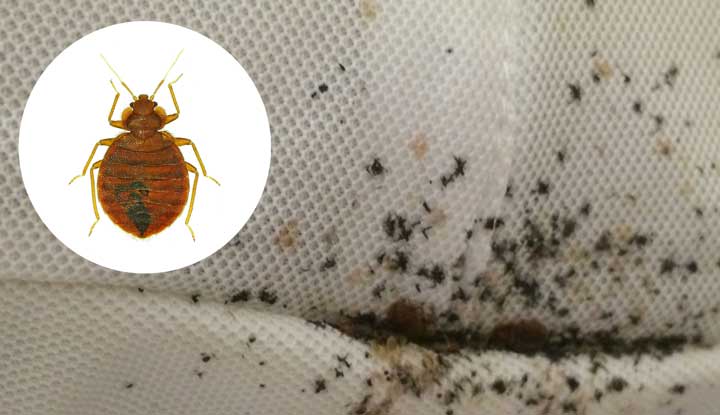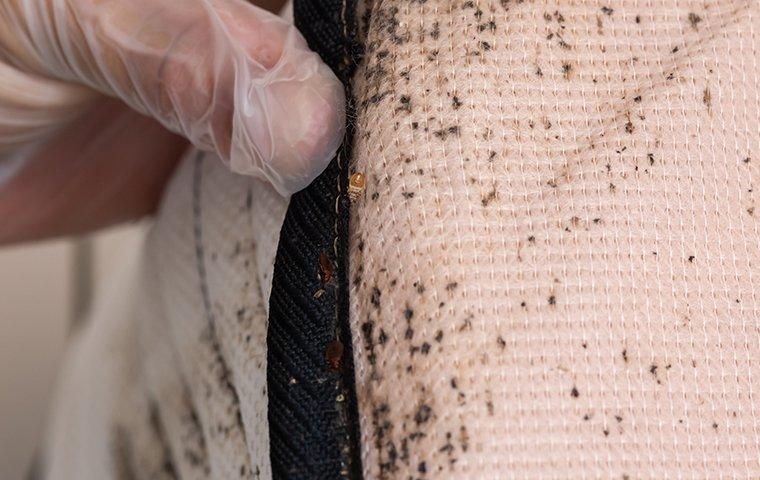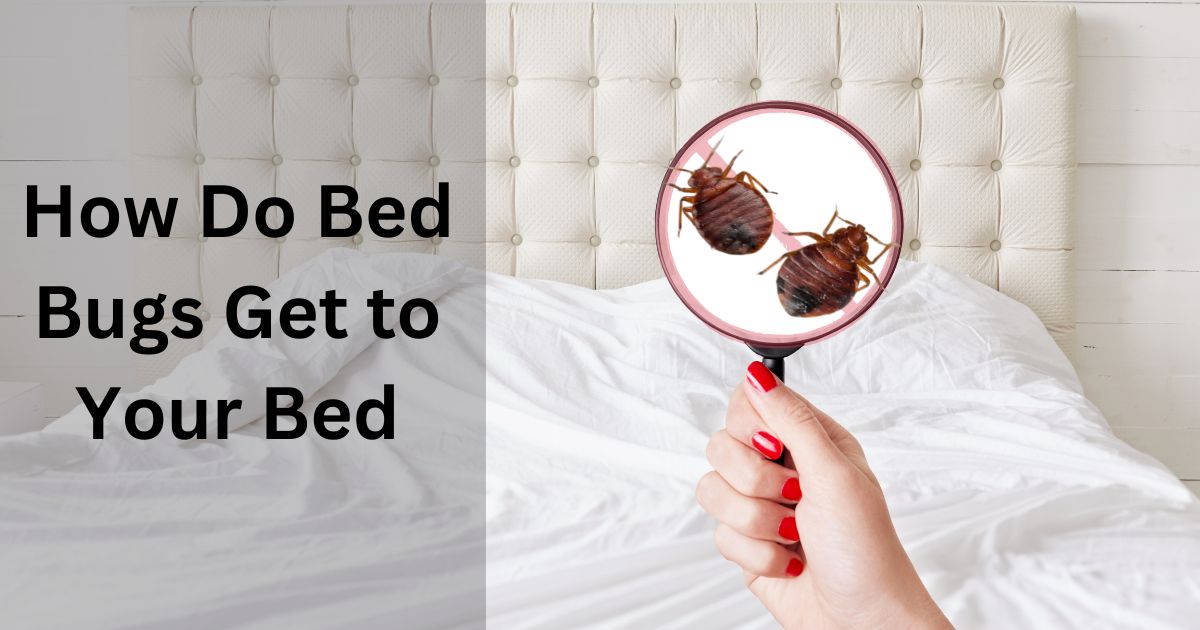Bed bugs can get to your bed by hitching a ride on clothing, luggage, or furniture. They can also travel between rooms through ductwork or cracks in walls and floors.
These tiny pests are skilled hitchhikers, making their way into homes through infested items. Once inside, they quickly spread to nearby areas, including beds, sofas, and other furniture. While they don’t have wings, they can move quickly and easily from one place to another.
This makes it important to be vigilant and take preventive measures to avoid infestations. We’ll explore the various ways bed bugs can find their way to your bed and what you can do to prevent them from invading your home.
:max_bytes(150000):strip_icc()/Bed-bug-control-tips-and-tricks-2656377-e580f433c55a4a98826e429753062084.jpg)
Credit: www.thespruce.com
Lifecycle Of Bed Bugs
Understanding the lifecycle of bed bugs is crucial to combat an infestation effectively. These resilient pests go through various stages of development, from eggs to adulthood. Let’s delve into the three main stages of their lifecycle.
Egg Stage
Bed bugs begin their lifecycle as tiny, translucent eggs. These eggs are about the size of a speck of dust, making them incredibly difficult to spot with the naked eye. Female bed bugs can lay hundreds of eggs throughout their lifetime, leading to rapid infestations.
Nymph Stage
After a week or two, the eggs hatch into nymphs, which are young bed bugs. At this stage, they require frequent blood meals to progress through several growth molts. Nymphs are small, pale, and often difficult to detect, making them adept at hiding in cracks and crevices.
Adult Stage
Once a nymph reaches adulthood, it becomes a full-fledged bed bug that is visible to the human eye, typically reddish-brown in color. Adult bed bugs are proficient in seeking out hosts for their blood meals, often hiding in mattresses, furniture, and other enclosed spaces near their feeding areas. They can live for several months without a meal, adding to the challenge of eradicating them.
Common Hiding Places For Bed Bugs
Bed bugs are notorious for their stealthy nature, making them experts at hiding out in unexpected places. Knowing their common hiding spots is vital for effective prevention and control. Understanding where they lurk can help in efforts to keep them at bay. Here are some of the most common hiding places for bed bugs:
Mattresses And Box Springs
Bed bugs prefer hiding in and around mattresses and box springs due to the easy access to their human host while they sleep. The seams and folds of these items provide perfect hiding spots for these pests.
Furniture And Upholstery
Furniture and upholstery are prime real estate for bed bugs. Sofas, chairs, and other upholstered items provide ample hiding spots for these pests to reside undetected.
Traveling Methods Of Bed Bugs
Hitchhiking On Clothes And Luggage
Bed bugs can latch onto clothes and luggage, hitching a ride to your bed.
Crawling Through Cracks And Crevices
Bed bugs squeeze through tiny cracks and crevices to access your sleeping area.
Factors That Attract Bed Bugs
Bed bugs are attracted to warmth, carbon dioxide, and the scent of humans, making them keen on finding their way to your bed. They hitchhike on clothing, luggage, and furniture, easily making their way into your home. Clutter and crevices also provide ideal hiding spots for these pests.
Factors that Attract Bed BugsBed bugs are pesky little insects that have a knack for finding their way into our homes. But how do they end up in our beds? There are several factors that attract bed bugs to our sleeping quarters. These factors include the presence of carbon dioxide and cluttered living spaces. By understanding these factors, you can take steps to minimize the risk of a bed bug infestation in your home.Presence of carbon dioxideBed bugs have a remarkable ability to detect the carbon dioxide that we exhale when we sleep. This is one of the primary ways they locate their hosts. As we sleep, our bodies release carbon dioxide, and bed bugs, with their keen sense of smell, are drawn to the source. Once they detect the carbon dioxide, they will make their way towards our beds, where they can easily access a blood meal.Cluttered living spacesCluttered living spaces create the perfect hiding spots for bed bugs. These tiny pests can easily hide in piles of clothing, stacks of paper, or even in the crevices of furniture. When your living space is cluttered, it becomes difficult to detect and eliminate bed bugs. They can easily move from one hiding spot to another without being noticed. Additionally, clutter provides bed bugs with ample hiding places near their preferred feeding grounds – our beds.To minimize the risk of bed bugs infesting your bed, it’s important to keep your living space clean and clutter-free. Regularly declutter your rooms, keeping items off the floor and organizing your belongings. By doing so, you can make it harder for bed bugs to find suitable hiding spots and reduce the likelihood of an infestation.In conclusion, the presence of carbon dioxide and cluttered living spaces are two factors that attract bed bugs to our beds. By understanding these factors, you can take proactive measures to minimize the risk of a bed bug infestation. Keep your living area clean and clutter-free, and ensure proper ventilation in your bedroom to reduce the concentration of carbon dioxide.Signs Of Bed Bug Infestation
One of the most frustrating experiences you can have as a homeowner is discovering a bed bug infestation. These tiny pests can quickly turn your cozy haven into a nightmare. But how do bed bugs actually get to your bed? To help you identify the signs of a bed bug infestation, here are two common indicators you should be on the lookout for.
Red Itchy Bites On Skin
One of the telltale signs of a bed bug infestation is waking up with red, itchy bites on your skin. These bites are often found in clusters or straight rows, as bed bugs tend to feed in a linear pattern. The bites are usually painless at first but can become increasingly itchy and inflamed over time. If you notice these red, itchy bites appearing on your skin, it’s a strong indication that you may have bed bugs in your home.
Small Bloodstains On Sheets
Another common sign of a bed bug infestation is the presence of small bloodstains on your sheets. When bed bugs bite, they inject an anticoagulant into your skin to prevent blood from clotting. As a result, you may notice tiny blood spots on your bedding or pajamas. These bloodstains can range in size from small specks to larger dots, depending on the extent of the infestation. If you spot these characteristic bloodstains on your sheets, it’s a clear indicator that bed bugs have made their way into your sleeping area.

Credit: my.clevelandclinic.org
Prevention And Control Measures
Bed bugs can easily find their way into your bed and wreak havoc on your sleep. Prevention and control measures, such as regular cleaning, sealing cracks, and using bed bug-proof mattress covers, can help keep these pests at bay and ensure a peaceful night’s rest.
Bed bugs can be a nuisance and disrupt your peaceful slumber. Implementing prevention and control measures is crucial to keep these pesky pests at bay.
Regularly Check For Signs Of Bed Bugs
- Inspect your mattress and furniture regularly for small reddish-brown bugs.
- Check for eggshells and dark fecal spots on bedding and walls.
- Be vigilant in detecting early signs to prevent infestations.
Vacuum Frequently And Wash Bedding In Hot Water
- Vacuum your mattress, bed frame, and surrounding areas weekly.
- Wash bedding, curtains, and clothes in hot water to kill bed bugs.
- Dry items on high heat to ensure complete eradication of bed bugs.
Professional Bed Bug Treatment
When bed bugs infest your home, it’s crucial to understand the importance of professional bed bug treatment. Professional exterminators are equipped with the knowledge and tools to effectively eradicate bed bugs from your living space, ensuring that you can sleep soundly once again.
When To Seek Professional Help
If you’ve tried DIY methods without success, it’s time to seek professional bed bug treatment. Additionally, if the infestation is severe or widespread, professional intervention is necessary to effectively eliminate the pests.
Different Treatment Options Available
Professional bed bug treatment offers various options to suit your specific needs. From heat treatments to eco-friendly solutions, there are a range of methods to eradicate bed bugs and prevent their return.

Credit: www.accuratepestsolutions.com
Frequently Asked Questions Of How Do Bed Bugs Get To Your Bed
How Do Bed Bugs Get To Your Bed?
Bed bugs can be introduced to your bed through various means. They can hitch a ride on your clothing or luggage when you stay in infested hotels or homes. They can also crawl through cracks and crevices in walls, floors, and furniture to reach your bed.
Additionally, bed bugs can spread from neighboring infested areas, such as adjoining rooms or apartments.
Can Bed Bugs Fly Or Jump?
No, bed bugs cannot fly or jump. They are small, wingless insects that rely on crawling to move from one location to another. However, they are excellent climbers and can easily crawl onto your bed or furniture, making it important to take precautions to prevent their access.
What Are The Signs Of A Bed Bug Infestation?
The signs of a bed bug infestation include small red bites on your skin, bloodstains on your sheets or pillowcases, and dark spots or droppings on your mattress or furniture. You may also notice a musty odor in the infested areas.
If you suspect a bed bug infestation, it is important to take immediate action to prevent their spread.
Conclusion
In understanding how bed bugs reach your bed, remember prevention is key. Regular inspection and cleanliness can aid in avoiding bed bug infestations. Stay vigilant and take prompt action if you suspect an issue. Protect your sanctuary for a peaceful night’s sleep.
Related posts:

I’m MD Tanvir, and I bring years of expertise gained from working closely with pest control companies to the forefront. My journey in the industry has inspired me to launch Bug Battler, a platform aimed at equipping people with the know-how to combat pests autonomously. Through Bug Battler, I aim to empower individuals with practical insights to tackle pest infestations effectively.

